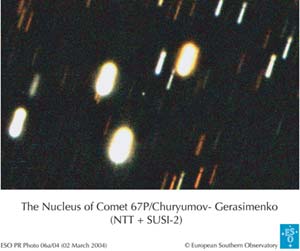ESO’s Telescope Takes Picture of ESA’s Rosetta’s Target, Comet 67P/Churyumov-Gerasimenko

In the morning of March 2, the Rosetta spacecraft was launched on board an Ariane-5 launcher from the European Spaceport in Kourou, French Guiana. The European Space Agency (ESA) spacecraft will be the first to land on a comet.
Before the launch, and as a salute to their colleagues at ESA, astronomers used the New Technology Telescope at the European Southern Observatory (ESO) of La Silla in Chile to image Rosetta’s target, Comet 67P/Churyumov-Gerasimenko, an approximately 4 kilometre size “dirty snowball” that orbits the Sun once every 6.6 years.
These new images show the object at a distance of approximately 670 million kilometres from the Sun – 4.5 times the distance from the Earth to the Sun.
These observations provide further confirmation that at this distance the activity on 67P/Churyumov-Gerasimenko is very low.
This is very good news for the mission, because it means that when Rosetta will meet in 2014 its target comet, at 790 million kilometres from the Sun, there will not be so much dust near the nucleus to hinder the landing.
Originally timed to begin about a year ago, Rosetta’s journey had to be postponed. This delay meant that the original mission’s target, Comet Wirtanen, which was observed two years ago by astronomers using ESO’s Very Large Telescope (see ESO PR Photo 06/02) could no longer be reached. Instead, a new target has been selected, Comet Churyumov-Gerasimenko.
The observations presented here are part of a continuous effort by astronomers to monitor Rosetta’s target and provide the spacecraft controllers and the astronomers with very useful, regular updates, e.g., about the ’cometary weather’ at the time of arrival.
Media Contact
More Information:
http://www.eso.org/outreach/press-rel/pr-2004/phot-06-04.htmlAll latest news from the category: Physics and Astronomy
This area deals with the fundamental laws and building blocks of nature and how they interact, the properties and the behavior of matter, and research into space and time and their structures.
innovations-report provides in-depth reports and articles on subjects such as astrophysics, laser technologies, nuclear, quantum, particle and solid-state physics, nanotechnologies, planetary research and findings (Mars, Venus) and developments related to the Hubble Telescope.
Newest articles

A universal framework for spatial biology
SpatialData is a freely accessible tool to unify and integrate data from different omics technologies accounting for spatial information, which can provide holistic insights into health and disease. Biological processes…

How complex biological processes arise
A $20 million grant from the U.S. National Science Foundation (NSF) will support the establishment and operation of the National Synthesis Center for Emergence in the Molecular and Cellular Sciences (NCEMS) at…

Airborne single-photon lidar system achieves high-resolution 3D imaging
Compact, low-power system opens doors for photon-efficient drone and satellite-based environmental monitoring and mapping. Researchers have developed a compact and lightweight single-photon airborne lidar system that can acquire high-resolution 3D…





















